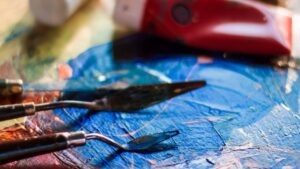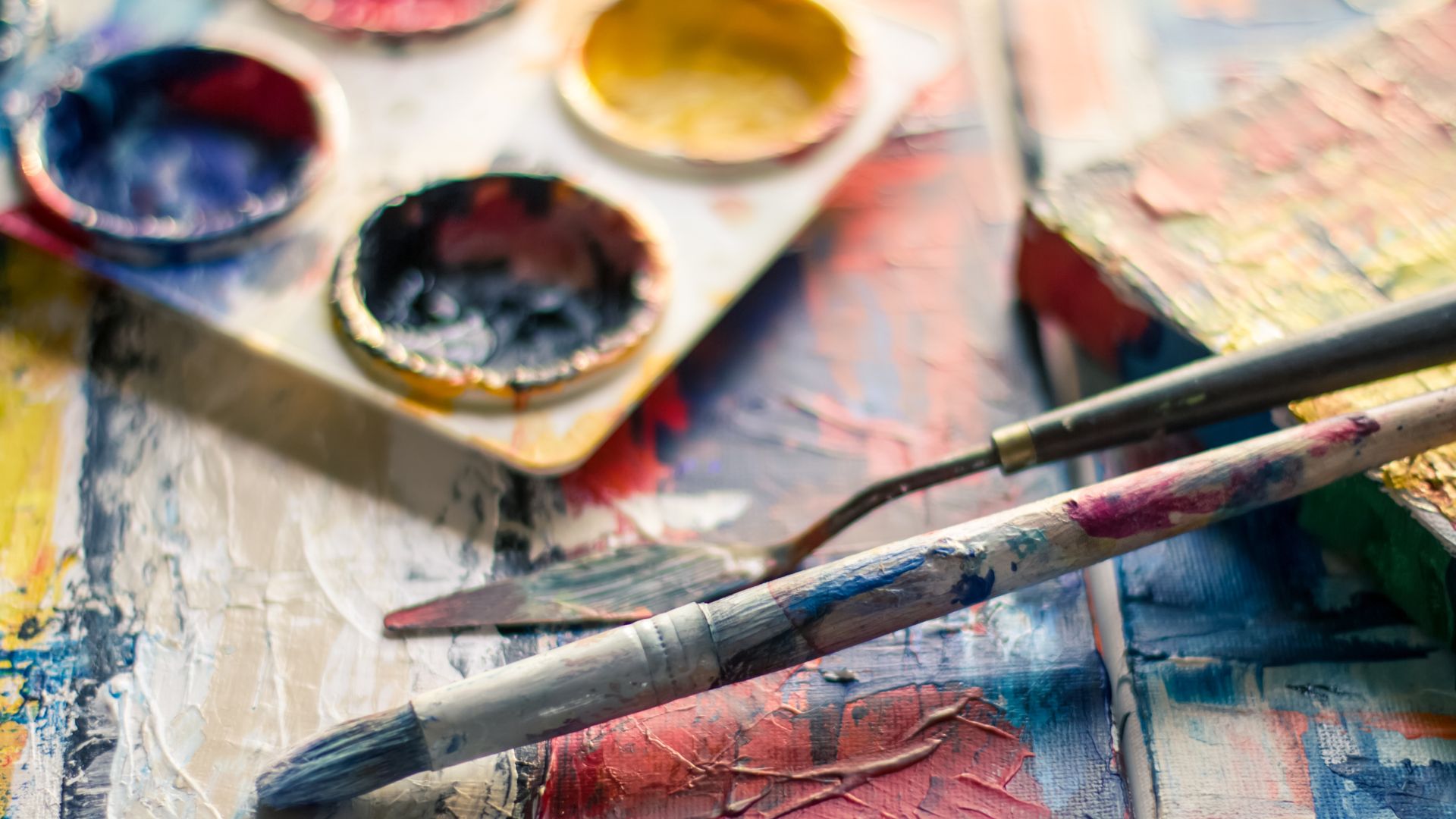When it comes to painting on canvas, selecting the right tools can significantly impact your artistic process and the outcome of your masterpiece. The tools you choose for applying wall paint to canvas can influence the texture, precision, and overall look of your artwork. Let’s dive into the best tools for this artistic endeavor.
Brushes: Your Artistic Allies
Brushes are the quintessential tools for painting on canvas. They come in various shapes, sizes, and bristle types, each serving a unique purpose.
- Flat Brushes: Ideal for covering large areas and creating straight edges or broad strokes.
- Round Brushes: Perfect for outlining, detailing, and creating intricate designs.
- Filbert Brushes: Offering a blend of the flat and round brush, they work well for blending colors and creating soft edges.
- Fan Brushes: Often used for blending, texturing, and creating foliage or special effects.
Palette Knives: Versatile Creators
Palette knives are fantastic for artists looking to add texture and depth to their paintings. These tools come in various shapes and sizes and can be used for applying paint, mixing colors, and creating unique effects by scraping, spreading, or layering paint onto the canvas.
Rollers and Sponges: Unconventional yet Effective
While primarily associated with wall painting, rollers and sponges can be surprisingly useful for canvas painting too. Rollers can help cover large areas quickly, providing an interesting textured effect, especially when experimenting with abstract art. Sponges, on the other hand, can be employed for blending colors seamlessly or creating distinct textures.

Airbrush: Precision and Control
For artists seeking precision and control in their artwork, an airbrush can be a valuable addition to their toolkit. This device atomizes paint, allowing for a fine, controlled application that can achieve gradients, intricate details, and smooth finishes.
Selecting the best tools for applying wall paint to canvas largely depends on your artistic style, preferences, and the effect you wish to achieve. Experimenting with various tools can unlock new creative possibilities and help you develop your unique artistic voice.
Techniques and Tips for Using Painting Tools on Canvas
Now that we’ve explored the array of tools available for applying wall paint to canvas, let’s delve into some essential techniques and tips to optimize your painting experience.
Brush Techniques: Mastering the Strokes
- Loading the Brush: Dip the brush into the paint and avoid overloading it. Experiment with different amounts of paint to achieve the desired consistency and coverage.
- Blending Colors: Use a clean brush or a blending brush to seamlessly blend colors together, creating gradients or smooth transitions between shades.
- Varied Strokes: Experiment with different brush strokes – from short, choppy strokes to long, flowing ones – to add texture and depth to your artwork.
Palette Knife Magic: Embracing Texture
- Mixing Paint: Use palette knives to mix colors directly on your palette. This technique allows for more controlled color blending and keeps your brushes clean.
- Creating Texture: Apply paint with the palette knife using different pressures and angles to create textured surfaces, adding dimension and interest to your painting.
Rollers, Sponges, and Unique Tools: Thinking Outside the Brush
- Texture Creation: Rollers and sponges can produce unique textures and patterns. Experiment with these tools to create unconventional and captivating effects in your artwork.
- Layering and Blending: Don’t be afraid to layer various tools and techniques. For instance, start with a roller to lay down a base color, then use brushes or palette knives to add details or refine the texture.
Airbrush Precision: Mastering Control
- Practice Control: Familiarize yourself with the airbrush’s controls and practice on a separate surface to understand its effects and how to achieve different levels of opacity and detail.
- Layering and Gradation: Utilize the airbrush for smooth color gradations and to build up layers gradually, creating depth and realism in your artwork.
Tips for Success:
- Experiment Freely: Don’t be afraid to experiment with different tools and techniques. Embrace the learning process and allow yourself to make mistakes – they often lead to new discoveries.
- Clean Your Tools: Properly clean and maintain your tools after each use to ensure their longevity and consistent performance.
- Explore and Learn: Take inspiration from other artists, tutorials, and resources to expand your knowledge and refine your skills.
Remember, the best tools for applying wall paint to canvas are the ones that resonate with your artistic vision and style. By mastering these tools and techniques, you’ll unleash your creativity, elevate your artwork, and create captivating paintings that speak volumes.
External Links for Further Exploration:
- The Spruce Crafts – Different Types of Paintbrushes and Their Uses: Explore a comprehensive guide to various paintbrushes and their specific uses in painting.
- Artists Network – Choosing the Right Palette Knife for Painting: Delve deeper into the world of palette knives and understand how to choose the right one for your artistic needs.
- Winsor & Newton – The Airbrush: A Comprehensive Guide: Learn more about airbrushing techniques and how this tool can elevate your painting skills.
Comparison tabular on this
Here’s a comparative table summarizing the different tools for applying wall paint to canvas:
| Tools | Description | Best Uses |
|---|---|---|
| Brushes | Available in various shapes and sizes; ideal for detailed work and blending. | Detailing, blending, creating varied strokes. |
| Palette Knives | Versatile tools for applying paint, mixing colors, and creating textures. | Adding texture, mixing colors, creating unique effects. |
| Rollers | Typically used for wall painting but can create interesting textures on canvas. | Covering large areas, creating unique textures. |
| Sponges | Effective for blending colors seamlessly or creating distinct textures. | Blending, creating textured effects. |
| Airbrush | Offers precision and control for creating gradients and intricate details. | Achieving controlled application and smooth finishes. |
Each tool has its unique strengths and best uses. Experimenting with these tools will help you discover which ones align best with your artistic style and desired outcomes in painting on canvas.
Wrapping up
Painting on canvas is a journey of creativity and expression, where the right tools become your allies in translating imagination onto a blank surface. From the versatile brushes to the texturizing palette knives, each tool offers a unique way to bring your vision to life. Embrace experimentation, master techniques, and find the tools that resonate most with your artistic voice. Whether it’s the precision of an airbrush or the texture created by rollers and sponges, let these tools be the companions that elevate your artistry and inspire your creative endeavors. So, pick up your brushes, knives, or even an airbrush, and let the canvas be your playground for artistic exploration and self-expression. Happy painting!

For over a decade, I’ve been Mike, an artist, crafter, and designer deeply immersed in the Croc world. I thrive on crafting unique, size-inclusive patterns, fostering creativity, and sharing them on ktforum.com. My designs aim to ignite your creative spark and delight you, ensuring clarity and ease of use through rigorous testing. Join me in expressing your creative flair and showcasing your craft with joy.
Related Posts
- Choosing the Right Canvas for Your Wall Paint
When it comes to transforming your walls into captivating artworks, selecting the right canvas is…
- Choosing the Right Brush for Painting on Canvas Walls
When it comes to painting on canvas walls, selecting the right brush can significantly impact…
- Should You Sand a Canvas Before Painting it with Wall Paint
When it comes to using wall paint on canvas, the question of sanding often arises.…
- Can You Paint Over Existing Wall Paint on Canvas
If you're an aspiring artist or someone enthusiastic about trying their hand at painting, you…

